
Financial Challenges :
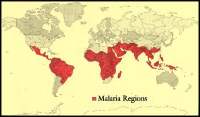 Did
you know that the amount spent on Malaria research annually in 1998 was only $84
million? Only? Well, in contrast, the annual expenditure on asthma research was
$800 million or 10 times as much.
Did
you know that the amount spent on Malaria research annually in 1998 was only $84
million? Only? Well, in contrast, the annual expenditure on asthma research was
$800 million or 10 times as much.
To see a map of the world-wide distribution of malaria and to read an article on
the lack of financial incentive for this cause,click on the image.
The article (originally published in "The Financial Times"),
unexpectedly, is pragmatic and constructive and details how the financial apathy
towards development of a malaria vaccine might be cured.

The Basics :
This article covers the lifecycle, the immune response and the exact effects
of vaccines directed at a particular part of the lifecycle of the parasite (e.g.
the erythrocytic phase). Recommended reading before you go on to the next
section.

Antigenic variation in malaria:
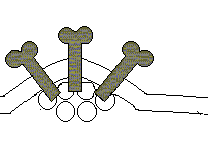 A short article explaining a
potentially important (from the point of view of developing a vaccine) antigenic
variation in the malarial parasite. Specifically, it describes a protein
involved in binding with the erythrocyte cell membrane, rapid variations in
which prevent the development of prompt immunity, resulting in the more serious
forms of malaria including cerebral malaria.... might be too technical for
everyone's liking...
A short article explaining a
potentially important (from the point of view of developing a vaccine) antigenic
variation in the malarial parasite. Specifically, it describes a protein
involved in binding with the erythrocyte cell membrane, rapid variations in
which prevent the development of prompt immunity, resulting in the more serious
forms of malaria including cerebral malaria.... might be too technical for
everyone's liking...

Current state of malaria vaccine
research
 The real meat of this review, this article records in detail the various
types of vaccines that are currently under research. It also provides a list of
institutions / Organizations / Projects involved in this endeavor.
The real meat of this review, this article records in detail the various
types of vaccines that are currently under research. It also provides a list of
institutions / Organizations / Projects involved in this endeavor.
Click on the image to go to the article. (and to know what this image is
doing in this section...)

Indian efforts :
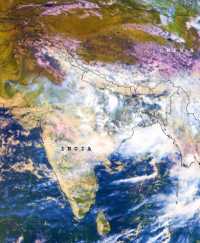 If the developed countries won't make a malaria vaccine for us ( Why should
they???? ) , maybe it is time to make a vaccine for ourselves. I am personally
aware of a program at TIFR (Colaba) which seeks to identify the
"constant" antigens in each phase of the malaria cycle. Once these
antigens are identified, a vaccine inducing an immune response against these
antigens could conceivably be formulated.
If the developed countries won't make a malaria vaccine for us ( Why should
they???? ) , maybe it is time to make a vaccine for ourselves. I am personally
aware of a program at TIFR (Colaba) which seeks to identify the
"constant" antigens in each phase of the malaria cycle. Once these
antigens are identified, a vaccine inducing an immune response against these
antigens could conceivably be formulated.
The article here however, details a candidate vaccine developed by ICGEB
(International center of Genetic engg. and biotechnology ) , New Delhi in collaboration
with PATH (Program for appropriate technology in health, an US NGO)
I always thought the hotbed of malaria vaccine research in
India was IISc (Banglore) where a certain Dr. Chitnis was involved in
malaria research. If you have any information regarding the research at this facility
or if you can find the same over the internet, please send it to me at oncogen@kemates.com
.

A new diagnostic test for malaria:
 This and the following articles digress from the topic of vaccines.
However, they are related to malaria and we thought them to be good enough to
include in this compilation.
This and the following articles digress from the topic of vaccines.
However, they are related to malaria and we thought them to be good enough to
include in this compilation.
This particular article details a new immunological test for the detection of
malaria. It's not the standard ELISA in that there are no enzymes invovled...
The indicator is colloidal Gold. Have a look anyway and tell me what
you think.

Malaria in Europe during the Middle ages :
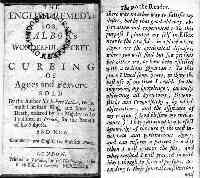 A very interesting article sprinkled liberally with pictures and graphs.
Although the article alludes mostly to Europe, it is nevertheless worth the time
taken to read it. Of particular interest to me was the part where the author
attempts to prove that an ancient disease named "Ague", was in all probability,
malaria.
A very interesting article sprinkled liberally with pictures and graphs.
Although the article alludes mostly to Europe, it is nevertheless worth the time
taken to read it. Of particular interest to me was the part where the author
attempts to prove that an ancient disease named "Ague", was in all probability,
malaria.
The author also tries to link changes in global temperature with the spread of
malaria, with a large measure of success.

Gallery :
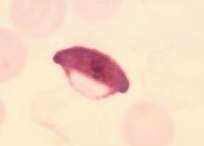 A collection of
microscopic images showing the Malarial parasite in various stages of
development. These are excellent images which deserve to be seen, especially by
the 2nd year students. I wish I had such a collection of images to go through
myself when I was a student...
A collection of
microscopic images showing the Malarial parasite in various stages of
development. These are excellent images which deserve to be seen, especially by
the 2nd year students. I wish I had such a collection of images to go through
myself when I was a student...
Click on the image to go to the gallery. Click on the thumbnails in the gallery
to view larger versions of the same.
(Image
on the left : Pl. Falciparum microgametocyte
with "bib")

![]()